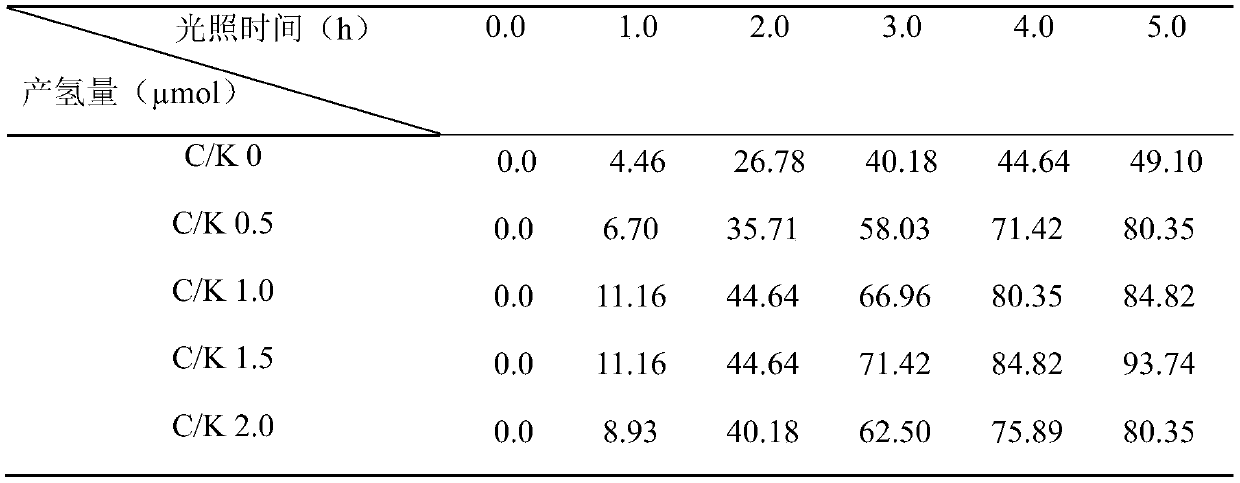Composite photocatalytic system cqd s -knbo 3 And its preparation method and application
A composite photocatalysis and photocatalysis technology, applied in the field of photocatalysis, can solve the problems of large band gap, low light utilization efficiency, and low utilization efficiency of photogenerated carriers, and achieve strong redox effect
- Summary
- Abstract
- Description
- Claims
- Application Information
AI Technical Summary
Problems solved by technology
Method used
Image
Examples
Embodiment 1
[0013] Example 1 Composite photocatalytic system CQD S -KNbO 3
[0014] 1. KNbO 3 Preparation of particles:
[0015] Preparation of KNbO by hydrothermal method 3 Particles. 3.57g Nb 2 O 5 Add the powder and 37.69g KOH flake solid to a beaker containing 19ml deionized water, stir on a magnetic stirrer for 30 minutes, until Nb 2 O 5 Mix well with KOH, and all dissolve. Then the mixture was sealed in a polytetrafluoroethylene lined stainless steel autoclave and heated at 160°C for 12 hours. Cool to room temperature. The product was ground to a granular shape, and then calcined in a muffle furnace. The calcining temperature was 400° C., and the calcining time was 1 h. Cool to room temperature and grind to obtain KNbO 3 Particles.
[0016] 2. Preparation of carbon quantum dots CQDs:
[0017] Preparation of CQD by hydrothermal method S . 1.6 g of ascorbic acid, 15 ml of ethylene glycol and 25 ml of deionized water were added to the beaker and stirred on a magnetic stirrer for 30 minute...
Embodiment 2
[0020] Example 2 Composite photocatalytic system CQD S -KNbO 3 Visible light catalytic degradation of crystal violet
[0021] (1) The effect of light time on the photocatalytic degradation of crystal violet
[0022] Visible light catalytic degradation: Take 50.0 mL of 10.0 mg / L crystal violet solution in a 100 mL conical flask, and add the CQD prepared in Example 1 S -KNbO 3 50.0mg, irradiated under visible light for 1.0~5.0h. Filter and measure its UV spectrum at 200-800nm. Take the absorbance at 582nm to calculate the degradation rate of crystal violet.
[0023] Degradation rate (%) = (C 0 –C) / C 0 ×100% (where C 0 : Concentration of stock solution; C: Concentration of sample). The results are shown in Table 1.
[0024] Table 1 Composite photocatalytic system CQD S -KNbO 3 Visible light photocatalytic degradation of crystal violet
[0025]
[0026] As shown in Table 1, with the prolongation of the light time, the degradation rate of the catalyst C / K 0, C / K 0.5, C / K 1.0, C / K 1.5 to ...
Embodiment 3
[0032] Example 3 Composite photocatalytic system CQD S -KNbO 3 Photocatalytic hydrogen production with crystal violet as sacrificial agent
[0033] (1) The effect of light time on the photocatalytic hydrogen production with crystal violet as a sacrificial agent
[0034] Method: Measure 500 mL of 50.0 mg / L crystal violet solution into a photocatalytic hydrogen production reactor, add 200.0 mg of the catalyst prepared in Example 1, and irradiate it under visible light for 1.0 to 5.0 hours. Gas chromatography was used to measure the amount of hydrogen produced in the reaction. The results are shown in Table 3.
[0035] Table 3 Composite system CQD S -KNbO 3 Visible light photocatalytic hydrogen production
[0036]
[0037] As shown in Table 3, with the prolongation of the illumination time, the hydrogen production of the catalysts C / K 0, C / K 0.5, C / K 1.0, and C / K 1.5 all increased with the increase of the concentration of CQDs. When the C / K is 1.5 and the light time is 5.0h, the amount...
PUM
 Login to View More
Login to View More Abstract
Description
Claims
Application Information
 Login to View More
Login to View More - R&D
- Intellectual Property
- Life Sciences
- Materials
- Tech Scout
- Unparalleled Data Quality
- Higher Quality Content
- 60% Fewer Hallucinations
Browse by: Latest US Patents, China's latest patents, Technical Efficacy Thesaurus, Application Domain, Technology Topic, Popular Technical Reports.
© 2025 PatSnap. All rights reserved.Legal|Privacy policy|Modern Slavery Act Transparency Statement|Sitemap|About US| Contact US: help@patsnap.com



